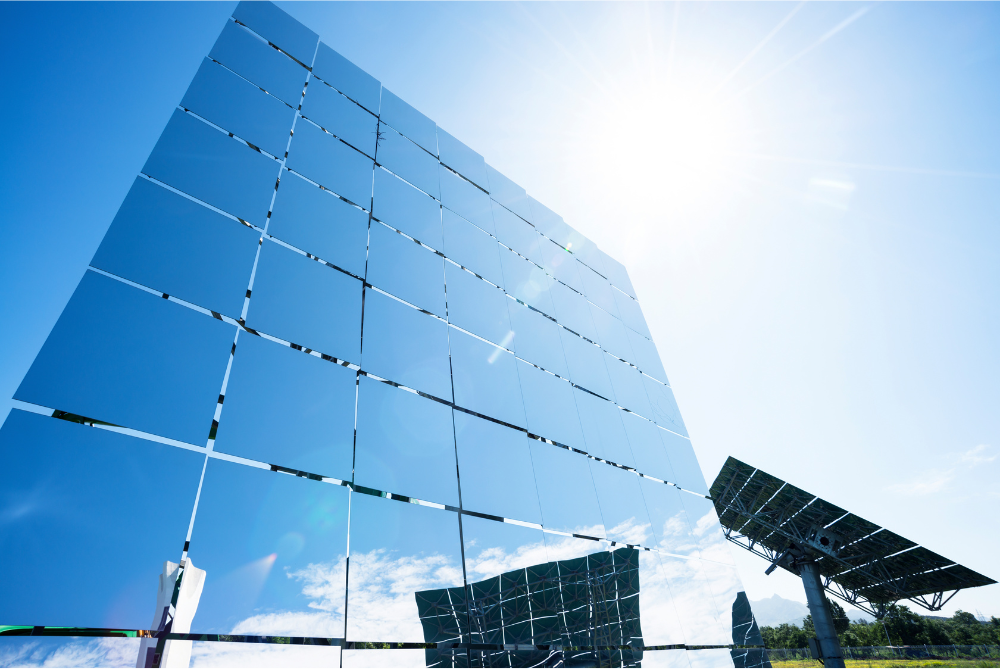
With many evolutionary technologies hitting the market, solar technology has progressed with the invention of a transparent solar panel.
These are the new generation of energy panels that use window surfaces to generate electricity. The prime motive is to save farmlands since the installation of large-scale solar panels requires a lot of space.
This is a new technique for gathering solar energy through windows or glass surfaces, often termed photovoltaic glass. It can transform any glass or window panel into an electricity-generating PV cell.
How Does A Transparent Solar Panel Work?
An invisible solar panel selectively traps sun rays that are not visible to the naked eye. It does so by using a Transparent Luminescent Solar Contractor (TLSC).
- The TLSC comprises organic salts that can absorb selected invisible UV rays and visible infrared light.
- The new ray formed is then directed towards the borders of the window lanes.
- The PV-coated window converts the new rays into usable energy.
The glasses are coated with a thin layer of photovoltaic ink or film. The TLSC has an efficiency of 10%. However, this can be increased by using them in every household and commercial place.
The efficiency of a Transparent Solar Panel
The efficiency of these panels is somewhat low compared to traditional solar panels, which is around 10 percent.
Poly solar panels have an efficiency of somewhere between 13 to 15 percent. Mono perc panels have an efficiency of about 16 to 21 percent. Bifacial modules have the highest efficiency rate (about 27 percent).
In comparison to all its peers, a partially transparent panel has an average efficiency of 7.2 percent. The amount of energy created depends on several factors like the window’s location and the amount of sunlight received. A large window solar panel is more efficient.
Pros And Cons Of Buying a Transparent Solar Panel
Before investing in a transparent panel, you should be aware of its advantages and disadvantages to decide whether to invest in one.
Advantages
- A transparent solar panel is less complicated to install than its traditional counterparts.
- Transparent solar panels are an excellent alternative source of power. They don’t require a lot of space and can be readily installed in windows.
- These invisible solar panels are very lightweight and; hence, portable.
- You can save on electricity bills by switching to invisible solar panels.
Disadvantages
- The percentage of power generated is less. You will have to purchase many such solar panels to provide electricity to a big house.
- One significant disadvantage of using transparent solar panels is that they come with special electrical devices like bulbs or plugs. It means that they will be incompatible with traditional electrical gadgets. Therefore, if you plan to install them, you will have to invest in new electrical devices that can be used with the panels.
- The invisible solar panel requires consistent sunlight consumption. Since their output is low on cloudy or rainy days, their performance is also affected.
- Transparent solar panels are composed of glass which makes them breakable. Therefore, they must be handled with caution. These panels are more susceptible to cracking or breaking if extra caution is not used when handling them.
Cost Of a Transparent Solar Panel
A transparent solar panel is expected to cost somewhere around ₹ 5,500 for one square metre. However, a lot about pricing depends on the size of the panel and the type you wish to install.
Solar electricity is capital intensive; therefore, the main cost incurred is on the equipment. The process followed in making the transparent panel is environmentally-friendly.
A transparent solar panel is cost-efficient because you can put a layer of PV-coated window glass on top of the windows with a little extra cost.
Maintenance Of A Transparent Solar Panel
Dust accumulation in the window panels decreases its productivity. The duration of cleaning a solar panel is determined by the density of pollution in your location.
If your home is adjacent to the roadside, the panels might need regular cleaning.
Cleaning a transparent solar panel is similar to cleaning traditional solar panels. You can use a wet sponge; however, it is always advisable not to use harsh chemicals or brushes. This might damage the solar panels.
It is essential to keep a monthly check on your solar panels to make sure they are working efficiently. Monitoring them helps make the most out of your solar panel investment.
Conclusion
Solar energy has emerged as the most cost-efficient energy. The transparent solar panel technology is attractive and has a promising future.
The transparent solar panels can block most of the infrared rays that heat the room. This automatically leads to cutting down on the usage of air conditioners and reducing the electricity bill.
Another considerable benefit of using these panels is that they do not require larger space for installation.
FAQs
Q1. What are the two types of transparent solar panels available in the market?
The two types are Partial transparent solar panels and full transparent solar panels.
The full transparent panel comes with an efficiency of 10 percent. The partial transparent solar panel has an efficiency of 7.2 percent.
Q2. Can transparent solar panels be the future?
Yes, transparent solar panels come with many advantages like reducing electricity costs. They can be used in any device – even car windows – to generate electricity.
Q3. Can we stack a transparent solar panel?
Yes, you can stack these solar panels as stacking can increase the efficiency by 10 percent without affecting the performance.
